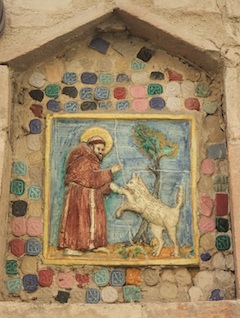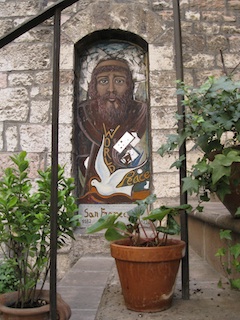St Francis of Assisi - an inspiring life
 |
 |
 |
Icon of St Francis on a wall in Assisi, Italy |
St Francis was born in Assisi in Umbria in Central Italy in 1181 or 1182 to a wealthy merchant family. His father traded mostly with France, and since his son was born while he was absent there, they called him Francesco, meaning “the Frenchman”, although he was baptised John.
As a teenager he was bent on enjoying himself and not much interested in studying or in his father’s business. However, in around 1201 there was a war between Assisi and nearby Perugia and Francis was taken prisoner by the Perugians. This was followed by a long sickness, which he bore with fortitude, and learned from it.
When he recovered, he decided to go to fight in southern Italy and set out with a fine horse and new equipment. But he met a poor man and swapped clothing with him. Later he had a series of dreams, telling him “to serve the master not the man”, and he began to visit the sick. Once he gave alms to a leper, and although the man’s sores were loathsome, he kissed him.
‘Francis, go and repair my house'
One day, as he was praying in San Damiano church, outside the Assisi town walls he heard a voice saying “Francis, go and repair my house, which you see is falling down.” He took the command literally, removed a load of cloth from his father’s warehouse and sold it and his horse to raise funds for repairs.
 |
| ‘It is no use walking anywhere to preach
unless our walking is our preaching’
– St Francis of Assisi
|
|
 |
 |
His father was furious, and demanded that he either return home or renounce his inheritance. He renounced his inheritance, gave his father back all the money and everything he owned, even the clothes he stood up in. He stripped off all his clothes, and was wrapped in the clothes of one of the Bishop of Assisi’s followers.
He walked the highways, begging, for two years, after which he returned to San Damiano and rebuilt it, stone by stone. Later he went to the tiny, ruined Benedictine Porziuncola chapel in the forest of Monte Subasio; he repaired that too, and took it has his hermitage.
On the feast of St Matthew he read the words saying “Do not possess gold… nor two coats nor shoes nor a staff,” and he immediately gave away his shoes, staff and girdle, and left himself with one undyed woollen coat which he held with a cord. This is the dress by which Franciscans today are known.
Slowly men joined him and when there were a dozen or so he drew up a short informal list of rules for them which he took to Rome in 1210. The Pope said that he was expecting too much of other men, that the intended poverty of this new body was impracticable. Yet the Pope later had a dream of St Francis propping up the Church, and so he approved the rule, but only verbally.
Brother Donkey
Francis would not accept any property. He called his body “Brother Donkey” because its role was to be burdened, beaten, and eat little. The monks worked for their daily bread in the fields, or begging (although they could accept food only, not money).
 |
 |
 |
Icon of St Francis on a wall in Assisi, Italy |
He gave them the title of Friars Minor, to show they were below all others. Despite the rigors of the rule, many men joined. “Would there were fewer Friars Minor,” he once said, “and that the world should so rarely see one as to wonder at their fewness.”
The Poor Clares
In 1212 a 19-year-old girl called Clare heard Francis preach in Assisi. She left home and joined him. He established her at San Damiano and the community later became the Order of St Clare, or The Poor Clares.
Francis lived at the Portiuncula chapel (in exchange for an annual gift of a basket of fish), and many stories are told of his life. He was known for his gentleness to animals.
Once, at Alviano he rebuked the swallows; “My Sister Swallows, it is my turn now to speak; you have been talking enough all this time.” There are stories of a rabbit at Lake Trasimene that would not leave him, and of a tamed wolf at Gubbio: some say these are allegory, others that they are true.
In 1223 he spent Christmas at the hermitage of Grecchio in the valley of Rieti, and, it is said, invented the first Nativity Play in the forest there, after which he remained there for some months in prayer.
The Stigmata
The following August he was in retreat in a small cell on Mount Alvernia (La Verna), with only Brother Leo with him. One night, remembered on September 17 in the Catholic calendar, he had a vision of himself flying with the seraphim (celestial beings), and then seeing the crucified Christ.
He awoke with the scars of nails in his feet and hands, and with a red, bleeding wound in his side: all of which reflected the scars of Christ on the cross, called the stigmata.
He lived for two more years, during which the stigmata were a source of weakness and his sight began to fail. Visiting St Clare at San Damiano he wrote the Canticle of Brother Sun which he set to a tune and taught to the brethren.
He travelled to Monte Rainerio and Siena to receive treatment but nothing worked. Back in Assisi they told him he had just a few weeks to live. “Welcome, Sister Death!” he said, and asked to be taken back to the Portiuncula by stretcher.
He had asked to be buried in the criminals’ cemetery, but the next day his body was taken to St George’s church in Assisi where it remained until 1230, after his canonisation, where it was removed to the great basilica built by Brother Elias.
He was just 44 or 45 at the time of his death. The three branches of Friars Minor, Friars Minor Capuchin and Friars Minor Conventual together made the one Order of St Francis and is the most numerous religious institute in the Catholic church.
Leading Cambridge theologian, Professor David Knowles said that by founding this brotherhood, St Francis “did more than any other man to save the medieval Church from decay and revolution”.
He had indeed fulfilled the request of the voice that had spoken to him when he was a very young man, and had repaired the Church, which was falling down. He has become known as the Second Christ because of the sheer scale and breadth of his love, not just for the poor and the despised, but also for his vision of all life as being part of the One Family.
His feast day is October 4, the day adopted by Catholics around the world to celebrate ecology and the natural world.
From Butler’s Lives of the Saints, Volume IV, Ed. Herbert J Thurston and Donald Attwater, London: Burns & Oates 1926-38 (reprinted 1986) pp 22-32
|

